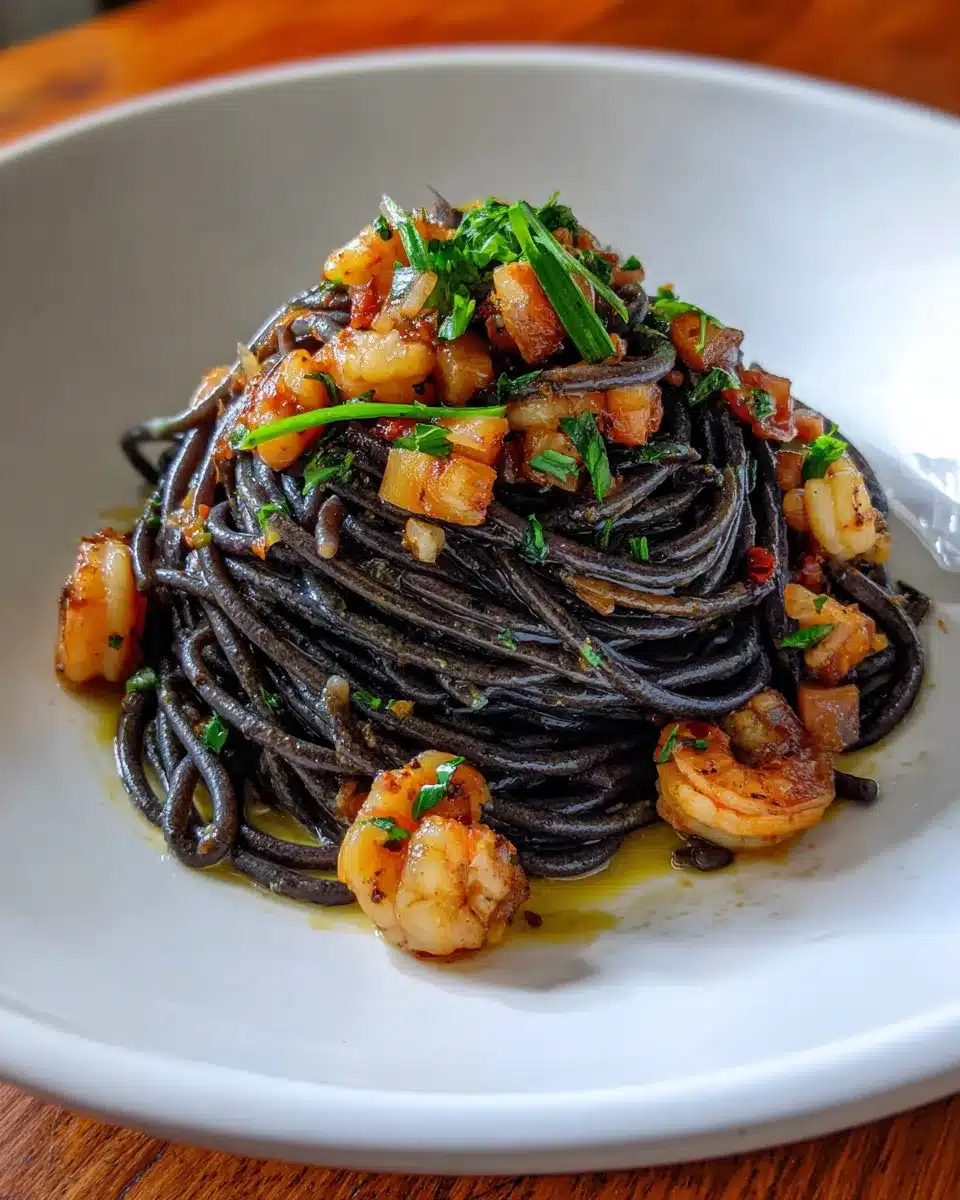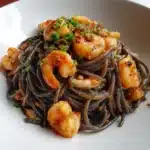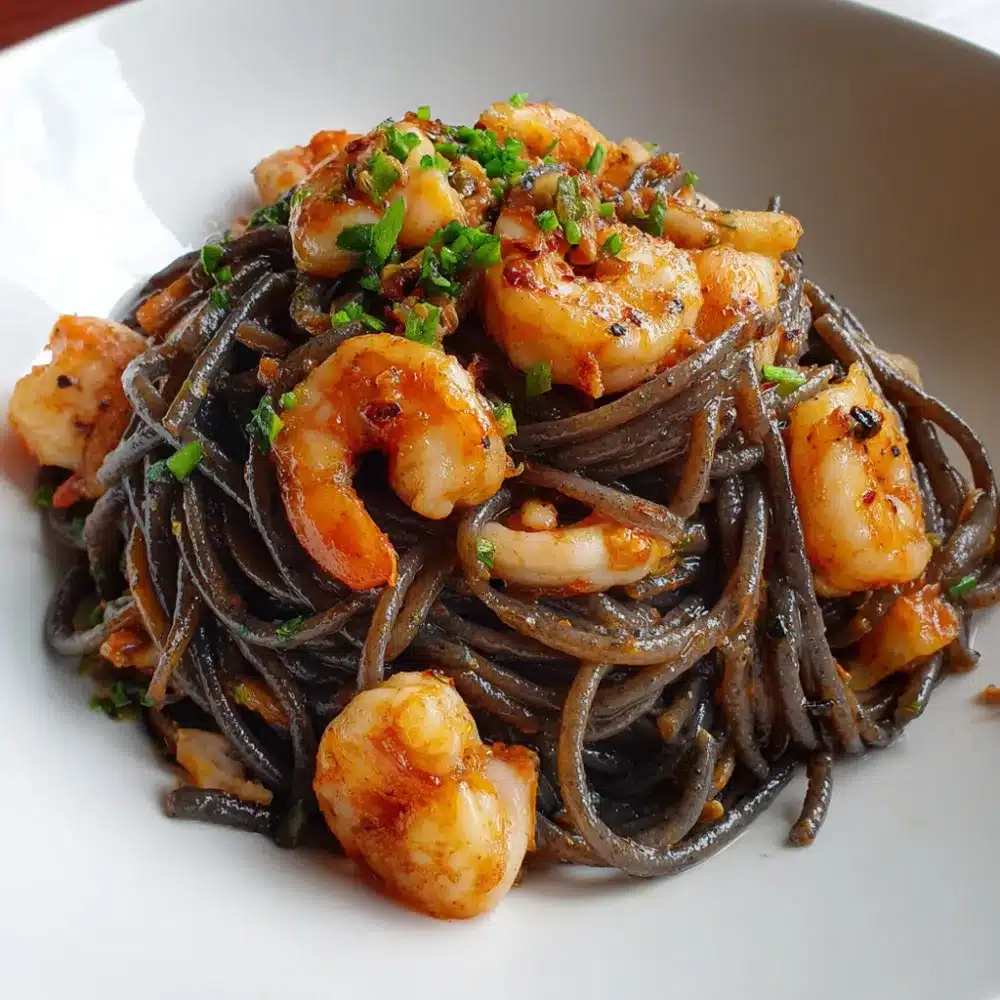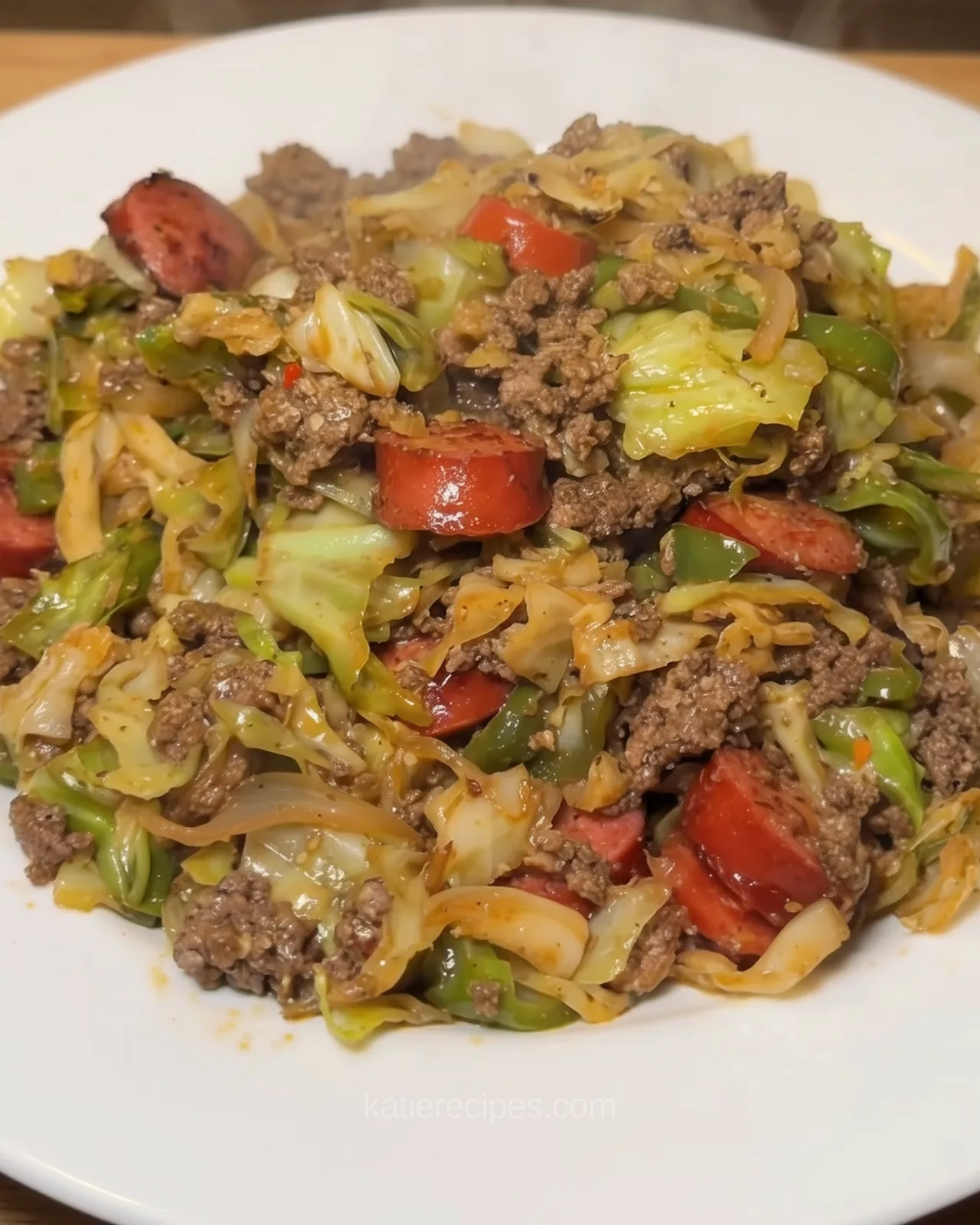Black spaghetti is more than just a unique type of pasta; it’s a culinary experience that captivates the senses with its striking appearance and rich flavors. Whether you’re a seasoned chef or a home cook looking to experiment, black spaghetti offers an exciting twist on traditional pasta dishes. This article will explore everything you need to know about black spaghetti, from its history and preparation to popular recipes and modern culinary trends.
Introduction to Black Spaghetti
When you think of pasta, images of golden strands of spaghetti or vibrant green fettuccine come to mind. But black spaghetti breaks the mold with its dramatic color, which comes from squid ink. This ingredient not only adds a deep, oceanic flavor but also gives the pasta its distinctive dark hue.
Squid ink has been used in Italian cuisine for centuries, particularly in coastal regions where seafood is a staple. Black spaghetti is a product of this tradition, combining the allure of the sea with the comfort of pasta. It’s a dish that stands out on any plate, making it a favorite among adventurous eaters and gourmet chefs alike.
For more on the history and making of squid ink pasta, check out The Spruce Eats’ guide on squid ink pasta.
The History of Black Spaghetti
The story of this recipe is intertwined with the culinary traditions of the Mediterranean, particularly Italy. Squid ink, the key ingredient, has been used for thousands of years in various dishes across different cultures. In Italy, it became a popular addition to pasta and rice dishes, especially in regions like Sicily and Venice, where seafood plays a significant role in local cuisine.
Squid ink was originally used to enhance the flavor of dishes, providing a briny, slightly bitter taste that complemented the sweetness of fresh seafood. Over time, black spaghetti evolved from a regional specialty to a dish celebrated worldwide for its unique appearance and flavor profile.
Today, it is not just confined to Italian kitchens. It has become a symbol of culinary creativity, featured in fine dining establishments around the globe. Whether served with a simple garlic and oil sauce or paired with luxurious seafood, black spaghetti continues to captivate palates with its rich history and bold flavors.
For more insights on the origins and health benefits of black pasta, visit Healthline’s article on black pasta benefits.
Types of Black Spaghetti
This dish comes in several variations, each with its unique characteristics. The most common type is made with squid ink, which imparts a deep black color and a slightly salty flavor. However, there are other types of black pasta made with different ingredients:
- Squid Ink Spaghetti: The most traditional and popular type, made with squid ink, which gives the pasta its deep black color and a subtle salty flavor. It’s widely used in Italian coastal cuisine.
- Cuttlefish Ink Spaghetti: Similar to squid ink spaghetti but with a slightly stronger, more intense flavor. Cuttlefish ink is often preferred for its richer taste.
- Activated Charcoal Spaghetti: This variation uses activated charcoal to achieve the black color. While it lacks the seafood flavor, it offers a unique aesthetic and a neutral taste, making it versatile for various dishes.
- Black Garlic Spaghetti: Infused with black garlic, this type of black spaghetti combines deep color with a sweet, earthy flavor. It’s perfect for those looking for a non-seafood alternative with a gourmet twist.
- Sepia Ink Spaghetti: Made with sepia ink, another type of ink from cuttlefish, this pasta has a rich, bold flavor similar to squid ink but with its distinct nuances. It’s often used in high-end seafood dishes.
Each type offers a different culinary experience, from the traditional to the innovative. Whether you choose to make black spaghetti from scratch or purchase it pre-made, the result is always a visually stunning and delicious dish.

How Black Spaghetti is Made
Making the recipe at home is a rewarding process that allows you to control the quality of the ingredients and customize the flavor to your liking. Here’s a step-by-step guide to making traditional squid ink spaghetti:
Ingredients:
- 200g semolina flour
- 2 large eggs
- 1 tablespoon squid ink
- Pinch of salt
Instructions:
- Get the dough ready: Mix the flour and salt in a large mixing dish. Create a well in the center and add the eggs and squid ink. Gradually mix the ingredients, kneading until a smooth dough forms.
- Rest the Dough: For about 30 minutes, cover the dough with a moist cloth and allow it to rest. As a result, the gluten may relax and roll out more easily.
- Roll and Cut: Using a pasta machine or rolling pin, roll the dough out into thin sheets. Cut the sheets into spaghetti strands, either by hand or with a pasta cutter.
- Prepare the pasta: Heat a big saucepan of water with salt until it boils. Cook the black pasta for 2-3 minutes or until al dente. Drain and serve right away with your preferred sauce.
Making this recipe at home not only gives you a sense of accomplishment but also ensures that you’re getting the freshest possible pasta. Plus, it allows you to experiment with different flavorings and ingredients to create a dish that’s uniquely yours.
Nutritional Value
Black spaghetti is not only a feast for the eyes but also a nutritious choice for pasta lovers. Here’s a breakdown of its nutritional value:
- Calories: Similar to regular pasta, black spaghetti provides a moderate calorie count, making it a suitable option for those mindful of their energy intake.
- Protein: The addition of squid ink adds a small amount of protein to the pasta, though it’s not a significant source.
- Minerals: Squid ink is rich in minerals like iron and zinc, which are beneficial for overall health.
- Antioxidants: The dark color of squid ink indicates the presence of antioxidants, which can help protect the body against free radicals.
When compared to regular pasta, black spaghetti offers a unique blend of nutrients, particularly due to the squid ink. It’s a great choice for those looking to diversify their diet with interesting and healthful ingredients.
Popular Black Spaghetti Recipes
One of the best things about this recipe is its versatility in the kitchen. It pairs wonderfully with a variety of ingredients, from seafood to vegetables, making it a great base for both classic and creative recipes.
Classic Black Spaghetti with Seafood
This is perhaps the most well-known way to enjoy black pasta. The salty flavor of the squid ink perfectly complements the sweetness of shellfish like shrimp, scallops, and mussels.
Ingredients:
- 300g black spaghetti
- 200g mixed seafood (shrimp, scallops, mussels)
- 3 cloves garlic, minced
- 1 tablespoon olive oil
- 1 cup white wine
- Fresh parsley, chopped.
- Salt and pepper to taste
Instructions:
- Cook the Pasta: Boil the black spaghetti until al dente, then drain and set aside.
- Prepare the Seafood: In a large pan, heat the olive oil and sauté the garlic until fragrant. Add the seafood and cook until just done.
- Add the Wine: Pour in the white wine and simmer until slightly reduced. Season with salt and pepper.
- Combine: Toss the cooked black spaghetti with the seafood mixture. Garnish with fresh parsley and serve hot.
Creative Vegetarian
For those who prefer plant-based meals, black spaghetti can also shine in vegetarian dishes. This recipe combines the earthy flavors of mushrooms with the richness of truffle oil.
Ingredients:
- 300g black spaghetti
- 200g mixed mushrooms (e.g., shiitake, cremini, oyster)
- 2 cloves garlic, minced
- 1 tablespoon olive oil
- 1 tablespoon truffle oil
- Fresh basil, chopped.
- Salt and pepper to taste
Instructions:
- Cook the Pasta: Boil the black spaghetti until al dente, then drain and set aside.
- Sauté the Mushrooms: In a large pan, heat the olive oil and sauté the garlic and mushrooms until golden brown.
- Season: Add the truffle oil and season with salt and pepper.
- Combine: Toss the black spaghetti with the mushroom mixture. Garnish with fresh basil and serve immediately.
These recipes are just the beginning. Black spaghetti is a canvas for culinary creativity, allowing you to explore different flavors and textures with each dish.
Cooking Tips and Techniques
Cooking black spaghetti may seem intimidating at first, but with a few simple tips, you can master this unique pasta:
- Don’t Overcook: Black spaghetti can become mushy if overcooked. Aim for an al dente texture, where the pasta is tender but still has a slight bite.
- Pair with Bold Flavors: The subtle saltiness of black spaghetti pairs well with bold ingredients like garlic, chili, and lemon.
- Use Quality Ingredients: Since the flavor of black spaghetti is delicate, it’s important to use high-quality ingredients, especially when it comes to seafood and olive oil.
- Cook in Small Batches: To prevent the pasta from sticking together, cook it in small batches and toss it with sauce immediately after draining.
By following these tips, you’ll be able to create delicious black pasta dishes that impress your guests and satisfy your taste buds.
Cultural Significance and Modern Trends
In the world of fine dining, black spaghetti has become a symbol of sophistication and culinary innovation. Its striking appearance and unique flavor make it a favorite among chefs looking to create memorable dishes.
Black Spaghetti in Fine Dining
The dish has become a symbol of elegance and creativity in fine dining, captivating both chefs and diners with its striking appearance and sophisticated flavor. This unique pasta, colored with squid ink, is often featured in Michelin-starred restaurants, where it’s paired with luxurious ingredients like lobster, caviar, or truffles. Its dramatic black hue adds visual intrigue to dishes, while the subtle brininess enhances the flavors of accompanying seafood or delicate sauces.
Black Pasta represents the intersection of tradition and innovation, making it a favorite choice for gourmet chefs aiming to create memorable culinary experiences.
Print
Black Spaghetti
- Total Time: 53 minutes (includes resting time)
- Yield: 2 servings 1x
Description
Traditional squid ink spaghetti with a striking black color and a rich, briny flavor. Perfect for an impressive seafood pasta dish.
Ingredients
- 200g semolina flour
- 2 large eggs
- 1 tablespoon squid ink
- Pinch of salt
Instructions
- Get the dough ready: Mix the flour and salt in a large mixing dish. Create a well in the center and add the eggs and squid ink. Gradually mix the ingredients, kneading until a smooth dough forms.
- Rest the Dough: Cover the dough with a moist cloth and let it rest for about 30 minutes to allow the gluten to relax.
- Roll and Cut: Roll the dough out into thin sheets using a pasta machine or rolling pin. Cut the sheets into spaghetti strands by hand or with a pasta cutter.
- Prepare the pasta: Boil a large pot of salted water and cook the black pasta for 2-3 minutes until al dente. Drain and serve immediately with your preferred sauce.
Notes
Use fresh squid ink for the most authentic color and flavor. Enjoy with a seafood sauce for a truly luxurious dish.
- Prep Time: 20 minutes
- Cook Time: 3 minutes
- Category: Main Course
- Method: Boiling
- Cuisine: Italian
Nutrition
- Serving Size: 1 serving
- Calories: 300
- Sugar: 0g
- Sodium: 120mg
- Fat: 4g
- Saturated Fat: 1g
- Unsaturated Fat: 2g
- Trans Fat: 0g
- Carbohydrates: 54g
- Fiber: 2g
- Protein: 10g
- Cholesterol: 90mg
Keywords: black spaghetti, squid ink, pasta, Italian, seafood





